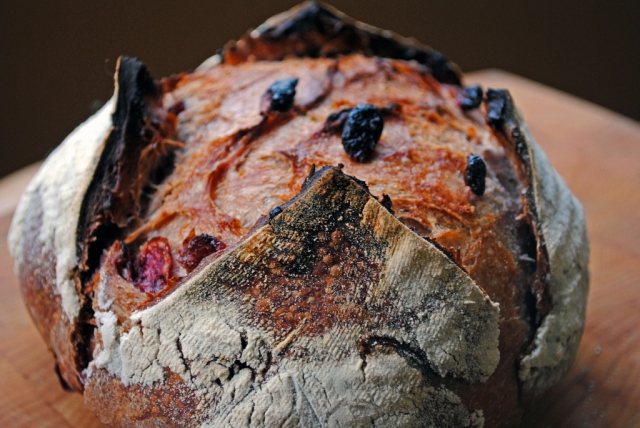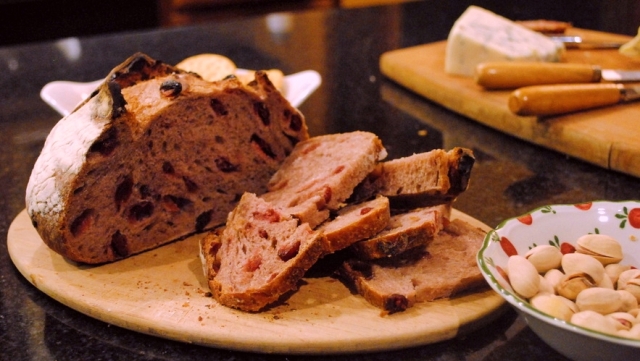The Fresh Loaf Forum is a virtual paradise for bread bakers, as not only very experienced folks share their best recipes, but you can also get feedback in case problems arise with a recipe. Last week I stopped by the site and the thread right at the top had the following title: Sourdough Wine Bread. That got my full attention. I clicked on it, and was blown away by the gorgeous photos, and the unusual color of the bread’s crumb, given by the wine and the dried cranberries. I revived my starter that same day, and started this bread on a Friday night. Sometimes you should not wait to chase a dream. RED WINE SOURDOUGH BREAD WITH DRIED CRANBERRIES
RED WINE SOURDOUGH BREAD WITH DRIED CRANBERRIES
(adapted from The Fresh Loaf Forum, bread by Yuko)
102 g sourdough starter (at 100% hydration)
288 g all-purpose flour
80 g water
123 g red wine
6.7 g Salt
80 g dried cranberries
In a bowl, mix flour, wine, and water roughly, cover it with plastic and keep for 12 hours in the fridge (autolyse).
Add sourdough starter and mix by folding dough in the bowl. Add cranberries and mix by folding dough in the bowl. Add salt and slap & fold for 3 – 4 minutes or until the dough becomes a ball. Bulk fermentation at room temperature, folding the dough every half and hour until it develops enough strength (I did 4 sets of folds).
Let it rise until the dough starts showing the yeast activity. It takes about 6 hours total depending on the temperature of your kitchen (I used my bread proofing box set at 78 F). Shape the bread as a boule (or 2 baguettes), place in a banetton or other appropriate container, and let it proof in the fridge for 16 to 18 hours.
Pull it out of the fridge and leave it out for one to three hours (see comments). Slash the bread and bake in a 450F oven with initial steam for a total of 40 minutes (for a boule), or 20 to 25 minutes for baguettes.
Cool on a rack before slicing.
ENJOY!
to print the recipe, click here
Comments: Preparing this bread had me worried up until the point I finally sliced it. Something seemed terribly wrong, as I detected very little fermentation, even though I kept the dough for almost 7 hours at 78 F. The original recipe called for retarding the dough in the fridge and shaping it next day, but my dough seemed so…. slow! I decided to shape it on the same day, and retard the dough in its final form, ready for the oven. Ideally, you should remove the bread from the fridge and allow it to almost double in size. That was not happening, so after a couple of hours I simply had to bake it.
Now, a little tangent. I usually wake up several times during the night, and tend to think about our experiments while trying to go back to sleep. Sometimes (unfortunately not that often), when I wake up again an hour or so later, I have a new idea to solve a problem or at least approach it. Almost as if during my sleep something goes to work “behind my back”… 😉 That Saturday night, I went to bed thinking about the red wine sourdough and why it seemed so weak. Exactly at 2am I woke up with one word blinking in my mind: SULFITES! All wine these days is preserved with sulfites! Maybe some batches have a higher concentration, maybe some of the bacteria or yeast in my starter was particularly sensitive to it. At any rate, one thing is certain: when you add red wine to make the dough the pH will be lower (higher acidity) so that will affect the efficiency of fermentation. Add to that the sulfites, and things can get trickier. Discussing these points in The Fresh Loaf forum, one of the bakers mentioned that when he adds wine to the dough the crumb of his bread gets tighter (indicating lower production of gas). For that reason, he normally tweaks his recipes to lower the alcohol and increase the water. Since in this case we are hoping for a nice red tint in the crumb, compromise is in order. I’d say keep the recipe as it is, and see how your starter behaves with it. Just for fun, I’ll try to find an organic red wine for my next “experiment”. Organic wines cannot have extra sulfites added, so the levels of the chemical will be low, ranging from 10 to 20 ppm (parts per million). Non-organic red wines often reach 125 ppm of sulfites or higher.
Even if the fermentation was not at its peak, this bread was delicious! I love the slightly sweetness given by the cranberries. My favorite match for the bread was a Maytag blue cheese, sharp and salty. Next day, slightly toasted, it seemed even better!
I am submitting this post to Susan’s Yeastspotting…
ONE YEAR AGO: Award-Winning Sourdough Baguettes
TWO YEARS AGO: Country Rye (Tartine)
THREE YEARS AGO: Penne a la Vechia Bettola


